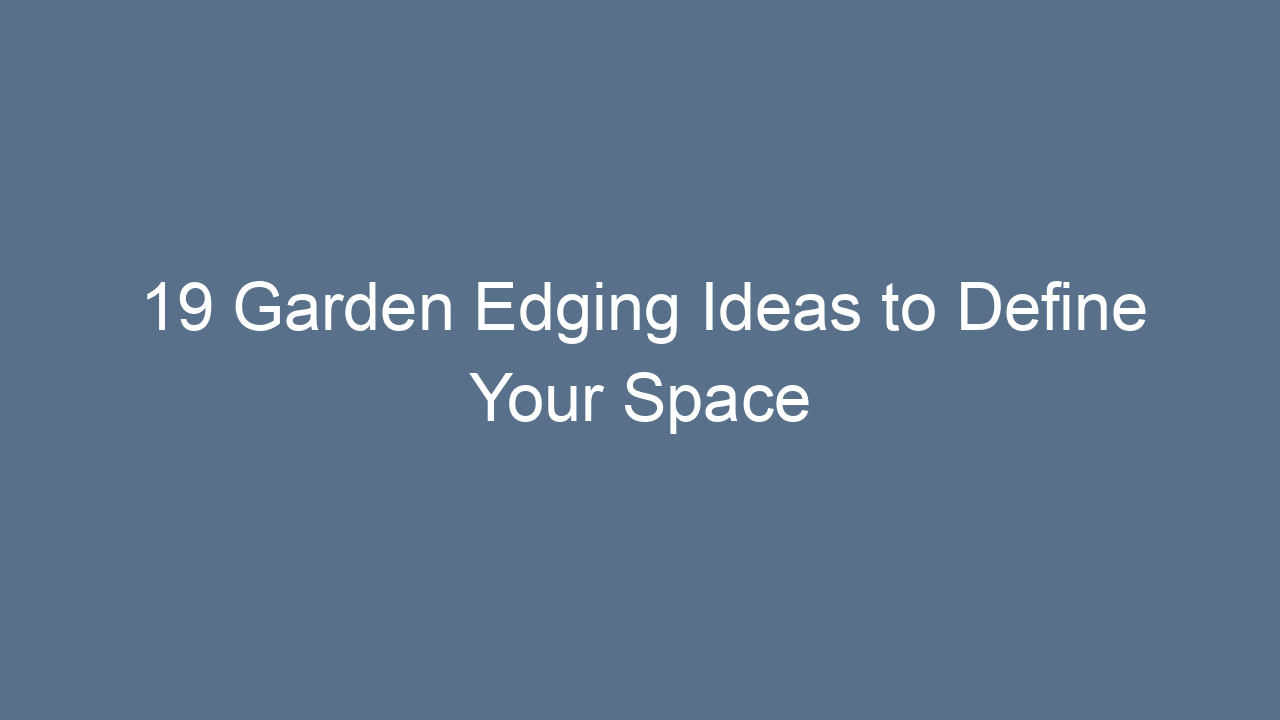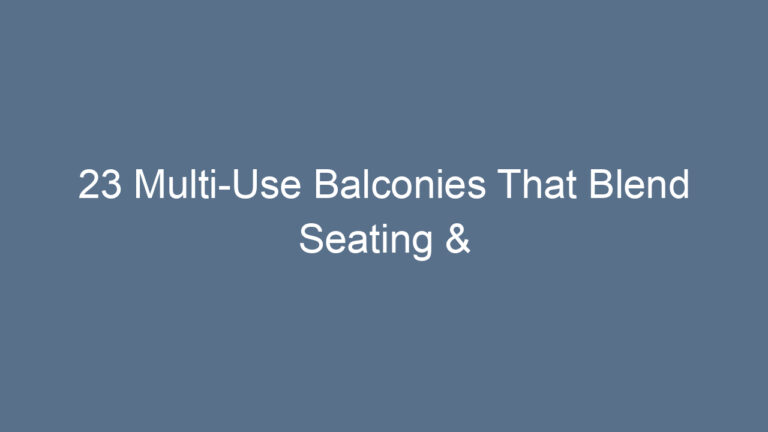19 Garden Edging Ideas to Define Your Space

Creating a beautiful garden is about more than planting flowers or shrubs. It’s about creating harmony, structure, and flow. One of the easiest ways to achieve this is with garden edging. By defining boundaries, garden edging adds visual appeal, prevents grass from invading flower beds, and makes maintenance simpler. Whether you’re working with a small backyard or a sprawling outdoor space, the right edging can transform your garden from chaotic to charming.
In this guide, we explore 19 creative garden edging ideas that not only define your space but also enhance its aesthetic. These ideas range from simple DIY projects to professional designs, giving you plenty of inspiration.
In This Article
- 1 1. Classic Brick Edging
- 2 2. Natural Stone Borders
- 3 3. Metal Garden Edging
- 4 4. Wooden Edging
- 5 5. Concrete Edging
- 6 6. Gravel Edging
- 7 7. Raised Garden Edging
- 8 8. Living Plant Edging
- 9 9. Decorative Fence Edging
- 10 10. Cobblestone Edging
- 11 11. Terracotta Edging
- 12 12. Recycled Material Borders
- 13 13. Plastic Edging
- 14 14. Brick-on-Edge Pattern
- 15 15. Rope or Twine Edging
- 16 16. Stone Pebble Borders
- 17 17. Concrete Blocks with Plants
- 18 18. Bamboo Edging
- 19 19. Mulch Borders
1. Classic Brick Edging
Brick edging is timeless and versatile. Bricks provide a solid border that can suit both formal and casual gardens. You can lay them flat, on edge, or even create a herringbone pattern for extra visual interest. Beyond aesthetics, bricks are durable, easy to install, and help prevent soil erosion. Their warm, earthy tones complement colorful flower beds perfectly. A fun trick is to paint bricks in subtle pastel colors for a whimsical touch—ideal for cottage gardens.
2. Natural Stone Borders
Using natural stones for edging adds rustic charm and texture. Stones come in various shapes, sizes, and colors, so you can create a unique border that blends seamlessly with your garden. They’re especially effective in rock gardens or around shrubs and perennials. The irregular shapes give a relaxed, organic feel, while stacked stones create a more structured appearance. Stones are low-maintenance and weather beautifully, developing character over time.
3. Metal Garden Edging
For a sleek, modern look, metal edging is hard to beat. Materials like steel, aluminum, or corten steel offer clean lines and long-lasting durability. Metal edges can curve gracefully around flower beds or stand straight to define pathways. One of the advantages is that it keeps grass and roots contained effectively. Additionally, corten steel develops a natural rust patina over time, blending industrial style with nature.
4. Wooden Edging
Wood creates warmth and softness in a garden. Treated lumber, cedar, or recycled wood can form borders that are natural and approachable. Wooden edges are perfect for informal gardens, vegetable patches, or paths. You can get creative with shapes, from straight lines to curved designs, or even cut logs into sections for a playful, rustic effect. Regular sealing helps prolong wood’s lifespan, keeping it resistant to rot and insects.
5. Concrete Edging
Concrete offers unmatched versatility. You can mold it into smooth curves, geometric shapes, or even stamped patterns that mimic natural stone. Concrete edging is durable, easy to clean, and requires minimal upkeep. For those who enjoy DIY projects, concrete can be poured on-site to fit exact garden specifications. You can also paint or stain it to match your garden theme.
6. Gravel Edging
Gravel is functional and aesthetically appealing. It works well along paths, driveways, and around flower beds. Gravel edges help with drainage, reduce weed growth, and are easy to maintain. You can use contrasting colors to make your garden pop or stick with neutral tones for a subtle effect. For extra charm, combine gravel with stepping stones or pavers.
7. Raised Garden Edging
Raised borders give height and structure to your garden beds. You can use wood, bricks, or concrete to lift your plants above ground level. This not only makes beds more visually striking but also improves soil drainage and protects delicate plants. Raised edging is especially practical for vegetable gardens, making harvesting easier. It also helps in controlling pests by creating a clear separation from lawn areas.
8. Living Plant Edging
Why not let your plants do the edging? Low-growing shrubs, herbs, or flowering perennials can form natural borders. Lavender, boxwood, and creeping thyme are popular choices. This method is sustainable, softens hard garden lines, and adds fragrance or color. Living edges also attract pollinators, enhancing your garden’s ecosystem. Regular trimming keeps the border tidy and defined.
9. Decorative Fence Edging
Miniature garden fences provide charm and structure simultaneously. They’re ideal for small flower beds, pathways, or themed gardens. Materials range from wood to wrought iron, offering both casual and elegant looks. A painted fence can add a pop of color, making your garden look playful and inviting. They’re also a gentle way to discourage pets from trampling plants.
10. Cobblestone Edging
Cobblestones add classic European charm. Their rounded edges create a soft, timeless look perfect for cottage gardens or pathways. Cobblestone borders are durable, can handle heavy foot traffic, and require minimal maintenance. Mixing different sizes or colors of stones adds depth and visual interest. Over time, moss or grass growing between stones can enhance the rustic appeal.
11. Terracotta Edging
Terracotta is warm and earthy, perfect for Mediterranean-style gardens. Terracotta pots cut in half or molded tiles can form an inviting border. This material is lightweight and easy to install. Terracotta also complements flowering plants, making beds pop with color. However, sealing it helps prevent weathering in wetter climates.
12. Recycled Material Borders
Eco-friendly gardeners love recycled materials. Old bricks, bottles, pallets, or tires can become creative garden borders. This method reduces waste, saves money, and adds a unique, personalized touch. For instance, painted bottles create a whimsical, colorful fence, while broken tiles offer mosaic charm. Creativity is the key to making recycled materials both functional and aesthetic.
13. Plastic Edging
Modern plastics provide affordable and flexible garden borders. They come in strips, spikes, or molded shapes, ideal for curved paths or irregular flower beds. Plastic edging resists rot, pests, and weathering, making it practical for long-term use. Some types even mimic wood or stone, giving the visual appeal of natural materials without the maintenance hassle.
14. Brick-on-Edge Pattern
Instead of the usual flat layout, placing bricks on edge creates height and emphasis. This technique works beautifully for contemporary gardens or to highlight pathways. The vertical orientation adds dimension and makes borders more noticeable. Pairing brick-on-edge with gravel or mulch can create a striking contrast and enhance garden depth.
15. Rope or Twine Edging
For a casual, coastal, or bohemian vibe, rope or twine can define garden edges. You can tie it between stakes or posts to create a soft boundary. This method is inexpensive, temporary, and ideal for gardens where flexibility is needed. Rope edging works well in vegetable gardens, children’s play areas, or seasonal flower beds.
16. Stone Pebble Borders
Smaller pebbles can create delicate, elegant edging. They work especially well around potted plants, pathways, or fountains. Pebbles are easy to arrange and can follow curved garden lines effortlessly. Choosing contrasting colors adds visual texture and highlights the plants’ beauty. Over time, pebbles shift naturally, giving a soft, relaxed appearance.
17. Concrete Blocks with Plants
Combining concrete blocks with small plants like succulents or herbs is both practical and decorative. You can stack blocks to create a mini raised bed while allowing plants to spill over the sides. This method blends hardscape and softscape, offering structure while promoting greenery. It’s ideal for modern or urban gardens with limited space.
18. Bamboo Edging
Bamboo adds an exotic, zen-like feel. Short bamboo stakes tied together or laid horizontally create natural, lightweight borders. Bamboo is sustainable, grows quickly, and resists pests. It’s perfect for tropical or Asian-inspired gardens, and its subtle color complements a wide range of flowers.
19. Mulch Borders
Mulch is simple yet effective for soft garden edging. Applying a thick layer of bark, wood chips, or straw along garden beds defines boundaries while retaining soil moisture. Mulch is inexpensive, natural, and encourages soil health. Combining mulch with rocks or small pavers enhances the visual effect while maintaining a soft, earthy look.






